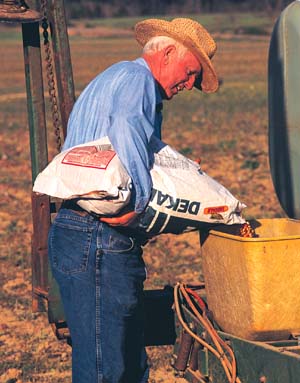Alabama Farmers To Plant Less Cotton

Tuscaloosa County farmer John E. Walker III has always considered himself a cotton farmer. But he won’t be planting any cotton this year. The reason, he said, is a combination of low prices and higher production costs.”We’re just trying to limit our losses,” Walker said. “With cotton prices the way they are, even if you make a crop, you have to have a pretty good yield just to break even. When you lose on cotton, you lose a lot more money than when you lose with soybeans and corn.”Consequently, Walker is planting 400 acres of corn and 500-600 acres of soybeans, and he’s letting another 300-400 acres lay idle. That’s a big change from last year, when he planted 700 acres of cotton, 450 acres of corn and 135 acres of soybeans.Walker isn’t the only Alabama farmer rethinking his planting options. According to the Alabama Agricultural Statistics Service, soybean acreage is expected to be up 21 percent this year while corn plantings will increase 8 percent. Cotton acreage is projected to be down 2 percent.The Statistics Service report showed Alabama farmers intend to plant 195,000 acres of corn, up from 180,000 acres last year. Soybean acreage is expected to rebound to 170,000 acres after falling to 140,000 acres in 2001. Meanwhile, the Statistics Service predicts cotton farmers will plant 600,000 acres, down from 610,000 acres last year. Peanut acreage also is expected to be down 10,000 acres, to 190,000 acres.Buddy Adamson, director of the Alabama Farmers Federation’s cotton and wheat and feed grains divisions, said the the high cost of producing cotton has contributed to the acreage shift.”You can grow corn or soybeans for about half of what you can grow cotton, so some farmers have decided to reduce their risks by planting these lower-cost crops,” he said.Walker figures he can produce soybeans for about $135 an acre, corn for $175-180 an acre, and cotton for about $400 an acre. With cotton prices hovering around 40 cents a pound, he would have to make a bale and a half per acre to break even, he said.By shifting some of his better land to soybeans, Walker hopes to improve his yields and his bottom line. Because he farms with the help of his wife, Peggy, son, John, and one part-time employee, he said the reduced acreage also will give him time to work on other farm projects–including the installation of an irrigation system.Although the Statistic Service report was based on farmer surveys, State Statistician Herb Vanderberry said actual planted acreage could change if Congress passes a new farm bill this spring.”Effects of weather during the planting season, availability and cost of production inputs, market prices and the pending farm bill are all factors in determining which crops and how much acreage Alabama farmers will actually plant,” he said. The agency will conduct another survey around June 1 to determine the acreage actually planted.But Walker said prices are so low, a new farm bill might not make much difference.”Regardless of whether the farm bill passes or not, commodity prices are low!” he said. “The reason most people continue to plant is they’ve got to pay the rent on their land, and they’ve got to make their equipment payments.”Nationally, farmers intend to plant 14.7 million acres of cotton, down 6 percent from last year. Corn acreage is expected to top 79 million acres, up 4 percent, while soybean plantings are projected to total 73 million acres, down 2 percent. The report showed peanut acreage at 1.5 million acres, down 5 percent.Alabama winter wheat plantings were down 12 percent to 150,000 acres while grain sorghum held firm at 12,000 acres.For more information about 2002 prospective plantings, visit the Alabama Agricultural Statistics Service website at www.aces.edu/department/nass.
